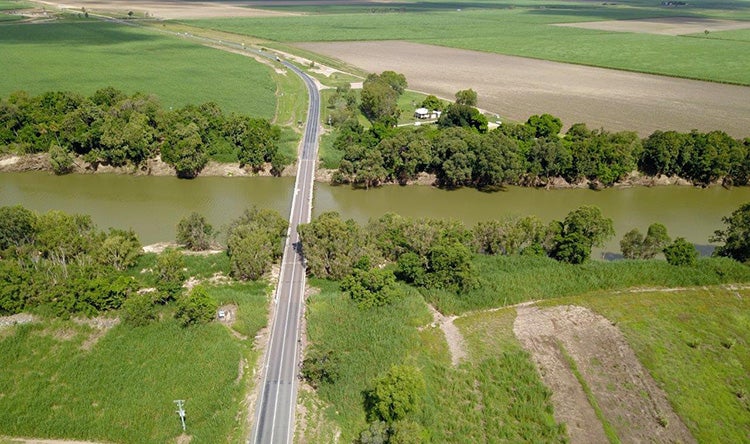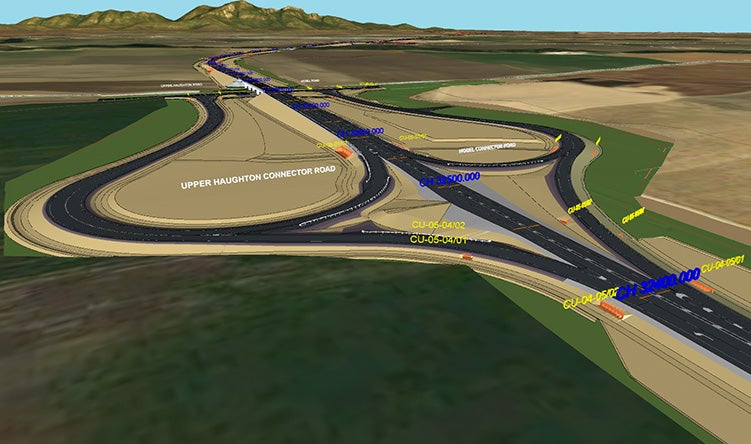Bruce Highway — Haughton River Floodplain Upgrade

Bruce Highway — Haughton River Floodplain Upgrade
Innovative Road Upgrades Improve Safety, Reduce Flood Vulnerability
The Haughton River Floodplain, located 50 kilometres south of Townsville, is one of the most complex floodplains in Queensland, Australia. The floodplain experiences regular flood events spreading for up to 13.5 kilometres along the Bruce Highway, part of the national land transport network. On average this section of highway, containing four main waterways, sugar cane railways, weirs and levees, closes every one to two years, isolating the township of Giru and significantly affecting locals, tourists, transport operators and other motorists.
HDR, in a design joint venture with Arup and through an alternate delivery model for the Queensland Department of Transport and Main Roads with The Infrastructure Group, designed replacements for a series of sub-standard waterway crossings to remove the flood vulnerability of the Bruce Highway across the Haughton River floodplain. Through the HDR and design joint venture team's unique and innovative approach, the final design solution reduced the number of bridges from 16 (during the reference design) to seven in detailed design. This saved more than 2000 linear metres of bridge, without significantly increasing the waterway area of transverse culverts. The improved flood immunity of the highway, which is a strategic link to North Queensland, will reduce average annual road closures from four days to one hour, providing a benefit to both commuters and the freight sector.
The AU$514 million upgrade also means improved safety for motorists. This is achieved through the replacement of three key bridges (including a wider Haughton River Bridge), realignment of the Reed Beds curve, upgrades to local intersections, provision of two grade-separated interchanges (removing two at-level sugar cane rail crossings), numerous intersection upgrades, 13.7 kilometres of pavement on a new alignment upstream of the existing highway, and the installation of wide centre line treatments.
A foam-stabilised pavement was adopted as sections of the new road alignment will still be prone to overtopping in severe weather. This will provide enhanced performance in saturated conditions and lead to a more resilient road network.
Construction of the Haughton River Floodplain Upgrade Project, including ancillary works such as the demolition of existing bridges, is expected to be completed by late 2021.

Firsts for Queensland
Our team employed world-first technologies and Queensland-first design innovations to engineer solutions that are set to change the face of linear infrastructure engineering in Queensland. The innovations, along with the collaboration of the team, delivered enormous benefits in terms of cost and effectiveness.
In a first for TMR, the team reacted quickly to recently updated earthquake design requirements in Australian bridge design standards. The project’s reinforcement detailing and design development for a Bridge Earthquake Design Category 02 in low-ductility prestressed concrete piles leads the way for future projects. This, along with relatively long spans for deck units, soft alluvium, large scour depths and aggressive soils resulted in the efficient design of the precast piles. For the main Haughton River Bridge, each pier comprises two 1500-millimetre diameter tubular steel piles designed to a new TMR technical specification, MRTS64. This is the first time any piles were designed to MRTS64 and this solution, put forward during the tender design, inspired the development of the specification. These piles are a practical solution as there is a reduction in the time of construction above water due to significantly reduced in-situ concrete works.
With a need to run multiple hydraulic modelling simulations, the team used custom-built hardware, colloquially known as The Hulk, to help run modelling software more efficiently. Coupled with multiple software licenses running across multiple high-specification machines, this approach reduced model simulation times. Multiple hydraulic options were analysed in the tight 16-week timeframe of competitive tender design.

Using Building Information Modelling to Improve the Process
Working closely with TMR, the project team went well beyond the standard delivery approach by providing sketch drawings at earlier stages of concept and preliminary design, created in support of a 3D BIM model.
By providing sketch drawings rather than full drawings, the time savings allowed the project team to spend more time detailing the project in the 3D BIM model. This followed a BIM management plan, developed in coordination with the client, detailing the models to be developed and deliverables to be created.
The BIM model also allowed locals to visualise the upgrade and see how it affected them. With information given to customers in a manner that could be quickly and easily understood in a local context with features they could recognise, changes were easily identified and addressed.














